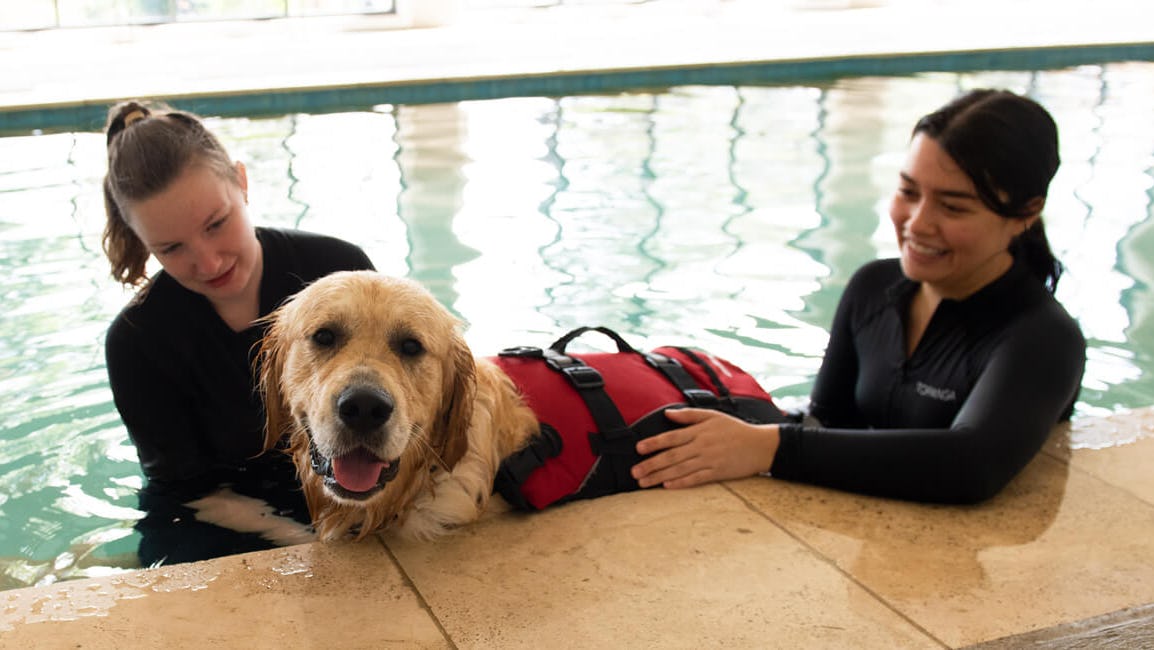Pool vs Underwater Treadmill

The word Hydrotherapy is a Greek word and means “water healing”.
Hydrotherapy has been recognised for its benefits and great results in rehabilitation of our pets. At K9 Swim we have the benefit of having an indoor heated pool and an underwater treadmill which we use both all the time. This gives us the advantage of deciding which one is more beneficial to our patients and can tailor their treatment plan accordingly.
Exercising in water is beneficial for pain, joint mobility, strengthening and balance. It assists in osteoarthritis, post-surgery recovery, weight loss, emotional and psychological states, training and conditioning.
What makes hydrotherapy so effective – it’s the water!
Density: Defined by specific gravity. This determines if an object will sink or float. Different body types will have a different density compared to the water. This would mean that a lean or muscled dog could sink where a dog carrying a lot of body fat would more easily float.
Buoyancy means that an animal is less affected by gravity because of the force of water so this makes the body lighter. This allows for non-weight bearing exercise. This can help with weak, paralysed or neurologically compromised dogs in order to allow them to stand and be upright in water. It reduces the stress and impact on joints as the dog moves through the water. The height of the water impacts the buoyancy – more water, more buoyancy.
Viscosity: This creates resistance as moving in water is slower, it strengthens muscles and gives a cardiovascular workout. Due to the water density, it is 4 times higher than walking on land.
Hydrostatic pressure means that the water is placing pressure over the surfaces of the body part that is immersed in water so the deeper the dog the greater the pressure. This can help with reducing swelling in a limb as it increases blood circulation.
Controlled temperature: Warm water helps soothe and relax joints and muscles and improves blood circulation.
What’s the difference between the pool and the underwater treadmill?
Both involve the use of water however they differ in how they can be beneficial to our patients.
How do we choose between swimming or underwater treadmill?
Indoor heated pool – non-weight bearing conditions are treated with swimming, as the floatation supports the entire body weight, and the limbs move freely without the “jarring” effect of exercising on hard ground.
Advantages of the pool
- Flexion of the joints is greater when swimming than walking in the water
- Swimming is completely non-weight bearing which removes all concussive forces on their joints
- Good for core strengthening
- Neurological patients who are unable to stand and support themselves will sometimes swim before they walk because the buoyancy of the water makes them “weightless”.
- Broader spectrum of conditions to be treated
- Allows those dogs with paralysis to neutralise their spine, stretch out, be buoyant and wonderful for mental stimulation.
- Passive movements can be conducted in the pool on the patient.
- Swimming is better than an UWT for cardiovascular fitness, weight loss and endurance and conditioning.
Disadvantages of the pool
- Swimming benefits flexion of joints more but is not as effective for improving extension like the UWT is.
- Can be intimidating for patients who are fearful or do not like water
- Minimal control of the patient’s movement
- Dogs sometimes do not use their hind limbs effectively when swimming
Underwater Treadmill
How does the underwater treadmill work?
The Canine Underwater Treadmill is a walking treadmill enclosed in a tank of warm water specifically designed for dogs. The dog walks into the tank and warm water gradually starts to rise to the correct level for their size and condition. The treadmill belt will then move, and the dog will walk for a set period. The treadmill’s resistance and speed is controlled and adjusted for each dog’s condition. Once the dog has finished their session, the water then drains out of the tank and the dog can easily walk down the ramp.
Advantages of The Underwater Treadmill
- Extension of the limbs/joints is better than in the pool
- Controlled speed and water levels improves benefit to your patient, supporting them and shortening recovery time.
- More balanced treatment for patients with multiple issues
- UWT achieves 60-70% weightless exercise without changing normal movement / gait patterns.
- Weaker patients can move better in water than on land
- Less intimidating than swimming for patients who are fearful of water
- Gentle and low impact enough for post-surgical patients
- Observation through the glass walls on all sides of the unit can monitor leg and gait movement
- The patient is weight bearing with resistance training in the water which results in faster muscle build up
Disadvantages of Underwater Treadmill
- Some patients are fearful of the belt moving under their feet and will refuse to walk
- Walking on a moving belt in the water requires the patient to have some degree of coordination or body awareness which can be very challenging for seniors or severe neurologic patients
- Some patients will try to float or sit down and not want to walk
- Less flexion of the limbs than in the pool
- Not suitable for patients if paralysed or can’t bear weight on the limb
